Ahhhh-Assisi. Spilling down the mountain from the ruined castle, each little laneway a delight to discover. The birthplace of Saint Francis and the final resting place for him as well, Assisi attracts tourists and pilgrims alike. There is no shortage of charm in this Umbrian hill town.
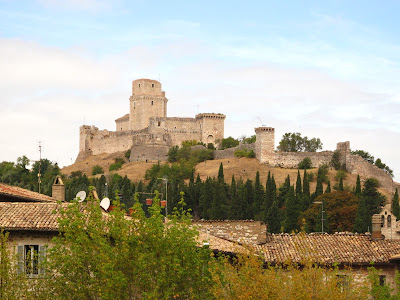 |
| Rocca Maggiore |
Assisi sits on the slopes of Monte Subasio facing West to capture what I think are the most sublime sunsets in all of Umbria. The area of Assisi was inhabited by the Umbrian tribes that settled in this region 1000 years BCE before being taken over by the Etruscans around 450 BCE. Eventually, the Romans moved in after winning a battle with the Etruscans in 295 BCE and built terraces down the slopes of Mount Subasio. The Romans named this settlement Asisium, and it thrived for centuries as part of a trade route to the Adriatic. There are many Roman ruins to be seen in Assisi such as a theatre, an amphitheatre, a Roman crypt under the church of St. Benedict and the Temple of Minerva which is now a Catholic church. The top of the town is dominated by a 12th-century castle called Rocca Maggiore, and there are the remains of a smaller yet older castle further up the slopes called Rocca Minore that also dates back to the Roman times.
 |
| "Streets" in Assisi |
Assisi is built on a VERY steep slope. We found cheap parking using our GPS at the bottom of the hill and walked (all the way up & UP & UP) to the top of the town to start our sightseeing adventures. By arranging our sightseeing in this way, we didn't have to go back to the top of town to get our car after a long day of walking around. The town of Assisi was a maze of little medieval alleyways or "viccolos" that were such a joy to explore, decorated with flowers and gardens at every turn. Luke used his "Maps.Me" app on his iPhone to navigate us through the medieval pathways which were like a maze through the town. Tip: "Maps.Me" is a FREE offline map resource that uses your phones' GPS system to navigate you. So you can find your way through the confusing streets without using your data!
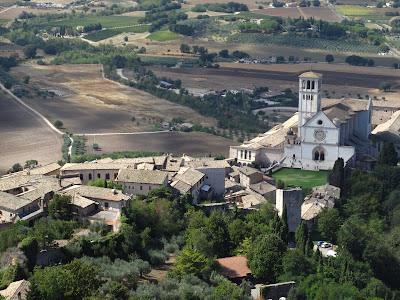 |
| View Of The Basilica From The Rocca |
When we neared the Roman walls of Assisi at the top of the town, Liam really wanted to go to check out the castle; so uphill to the ancient Rocca Maggiore we went. The Rocca was built around 1174 and has gone through many massive reconstructions over the centuries. There was an excellent display of weapons, period costumes, furniture and armour throughout the castle. Liam had a blast climbing up the tiny spiral staircases of the fortress, running along the ramparts and peeking out the little narrow windows. The 360-degree views from the top of the castle looking down on the Umbrian countryside were awe-inspiring. The entry fee is €5.50 or you could get a combo pass which includes the castle, Roman forum excavations and the art gallery for €8. Check out the tourist information for Rocca Maggiore
All that climbing around on the castle ramparts had made us hungry, so we found a romantic, casual restaurant (or "trattoria" in Italian) called "La Lanterna" tucked away in a little street off the main drag In Assisi, you were really spoiled for choice in atmospheric restaurants serving authentic Umbrian cuisine. Absolutely perfect! Pizza, prosciutto & melon, handmade pasta, wine; it was all delicious!
After our meal, we happily stumbled further down along the hill to Piazza del Comune which is considered the main square of Assisi. This is where the Roman forum of Asisium once stood and is still under the streets! You can go and visit the excavations, see Roman artifacts and walk down an ancient Roman road. If you bought a combo ticket for the Rocca, Pinacoteca (painting gallery) it is free entrance otherwise it is €4.
Also on the piazza is a great example of Roman architecture; the church of Santa Maria Sopra Minerva. Santa Maria Sopra Minerva literally translates to Saint Mary over Minerva, because this baroque-style church was built on top of a Roman Temple believed to be devoted to the Goddess Minerva.
The Temple was thought to have been devoted to Minerva because a statue of a Roman Goddess was found inside. Actually, the temple was built in the first century BCE in honour of the Roman God Hercules, but it is still called Sopra Minerva.
Later, the Christians then began to use this beautiful place of worship and dedicated this Pagan Temple into a Christian church. At one point the church was used in the middle ages as a tribunal and a jail; one of the famous frescoes by Giotto in St. Francis's Basilica shows Santa Maria Sopra Minerva with bars in the windows.
The energy in this building is incredibly old, and you can feel how special this place is as soon as you cross the threshold.
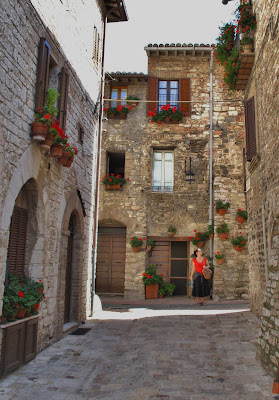 |
| Wandering The Pretty Streets Of Assisi |
All that climbing around on the castle ramparts had made us hungry, so we found a romantic, casual restaurant (or "trattoria" in Italian) called "La Lanterna" tucked away in a little street off the main drag In Assisi, you were really spoiled for choice in atmospheric restaurants serving authentic Umbrian cuisine. Absolutely perfect! Pizza, prosciutto & melon, handmade pasta, wine; it was all delicious!
After our meal, we happily stumbled further down along the hill to Piazza del Comune which is considered the main square of Assisi. This is where the Roman forum of Asisium once stood and is still under the streets! You can go and visit the excavations, see Roman artifacts and walk down an ancient Roman road. If you bought a combo ticket for the Rocca, Pinacoteca (painting gallery) it is free entrance otherwise it is €4.
Also on the piazza is a great example of Roman architecture; the church of Santa Maria Sopra Minerva. Santa Maria Sopra Minerva literally translates to Saint Mary over Minerva, because this baroque-style church was built on top of a Roman Temple believed to be devoted to the Goddess Minerva.
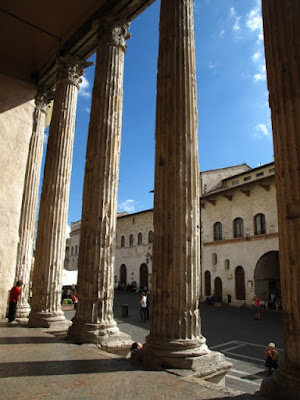 |
| Ancient Columns |
The Temple was thought to have been devoted to Minerva because a statue of a Roman Goddess was found inside. Actually, the temple was built in the first century BCE in honour of the Roman God Hercules, but it is still called Sopra Minerva.
Later, the Christians then began to use this beautiful place of worship and dedicated this Pagan Temple into a Christian church. At one point the church was used in the middle ages as a tribunal and a jail; one of the famous frescoes by Giotto in St. Francis's Basilica shows Santa Maria Sopra Minerva with bars in the windows.
The energy in this building is incredibly old, and you can feel how special this place is as soon as you cross the threshold.
 |
| Baroque Interior of Santa Maria Sopra Minerva |
 |
| Bell Tower From 13th C. |
I showed Liam where you can still see the gutters carved into the marble floors. The gutters were used to drain the blood from the altar during the ritual animal sacrifices that occurred here during Roman pagan times. My poor vegetarian son was horrified! Explaining art, history and religion to kids can really come alive when you are in these ancient places-it's always a teaching moment when you travel.
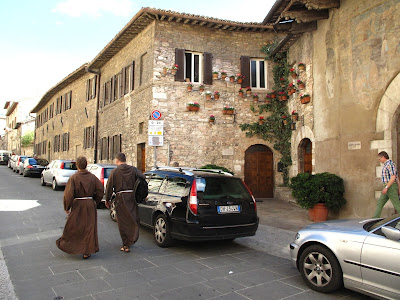 |
| Assisi street scene |
It's not all ancient churches here, religion is alive and well in Assisi and is one of the most important places of Christian pilgrimage. We saw some extreme starkly devout Franciscan monk pilgrims that wore nothing but a sackcloth, "walking" (and praying) on their knees to the Basilica. Also, there are many Franciscan monks walking around town together in their brown robes, hanging out or eating gelato. This reminded us that Assisi is a living holy place-not just a beautiful Italian hill town with a big church. Assisi is like an open-air museum for learning about the life of St. Francis and many of the places Francis frequented are still here. We decided to skip touring the rest of the other churches (and there are so many that are worth seeing) and head straight for St. Francis's Basilica.
 |
| Basilica entrance |
Wow. I mean, WOW! I just loved this church. There are 3 layers to the church; the basement is the tomb where St. Francis is actually buried, the early church built above it, and the upper street level is the "fancy church". The Basilica was hit by an intense earthquake in September 1997, that killed four people and injured many when the ceiling collapsed near the entrance. The church was closed for nearly two years while repair work was carried out. In 2000 the Basilica of Saint Francis became a UNESCO World Heritage site to help preserve the beauty and precious art within. TIP: IT'S FREE TO SEE THE CHURCH JUST REMEMBER NO BARE SHOULDERS OR KNEES ALLOWED.
 The Basilica was built in 1228 as soon as Saint Francis was canonized, two short years after he died at age 45. The highlight of the basilica was the frescoes on the upper church walls depicting scenes from St. Francis' life by the master painter Giotto. These outstanding frescos were created for us by Giotto to understand what St. Francis was trying to preach. Many of the concepts St Francis was teaching were really radical for his times, and yet Francis of Assisi was the equivalent of a rock star in his day-check out my blog on St. Francis the Rock Star of the middle ages!
The Basilica was built in 1228 as soon as Saint Francis was canonized, two short years after he died at age 45. The highlight of the basilica was the frescoes on the upper church walls depicting scenes from St. Francis' life by the master painter Giotto. These outstanding frescos were created for us by Giotto to understand what St. Francis was trying to preach. Many of the concepts St Francis was teaching were really radical for his times, and yet Francis of Assisi was the equivalent of a rock star in his day-check out my blog on St. Francis the Rock Star of the middle ages! In the upper level of the basilica, it got quite overcrowded with noisy tourists chatting away and taking photos. All of a sudden, an ethereal voice would loudly echo through the Basilica in a serene tone "Ssssssh! Silencio...ssssssssh!" Liam looked up at me with big eyes and asked: "Mom, Is that God talking?" I had to stifle a giggle because I thought the same thing at first. "No, it's the monk over there on the church PA system" I explained to him, and I pointed to a stern looking friar at a podium. Liam waited and watched for the monk to come over the PA system again to make sure I wasn't tricking him because he was sure it was God keeping an eye on these rowdy tourists.
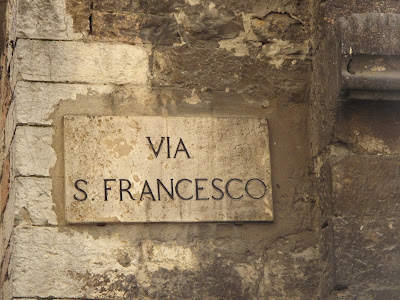
One of the most moving places in all of Assisi is the crypt of Saint Francis that is accessible through the lower church. Saint Francis's friend Brother Elias had hidden Francis's remains after his death so that they would not be scattered as relics all across Europe. The location of Francis's body became lost over the centuries. In 1818 Saint Francis's remains were discovered under the floor of the lower church, and this crypt was built to hold the remains of St. Francis and six of his good friends that became his most faithful brothers in spreading the word that "Nature is the mirror of God." I am not a Catholic, but I do recognize a brilliant man when I see one, and spending time in the crypt of St. Francis and perhaps lighting a candle and making a wish for environmental recovery seemed like a good idea.


